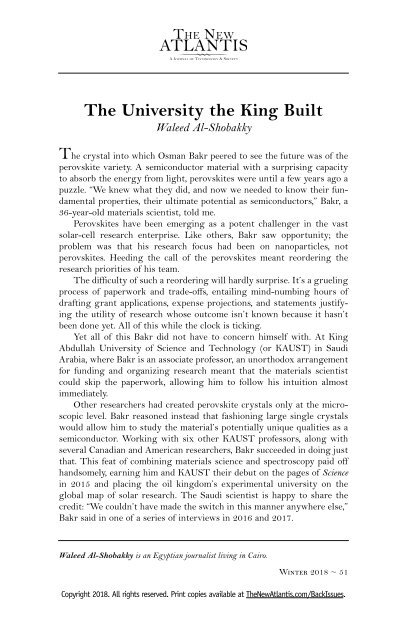The New Atlantis - Winter 2018 (Issue 54) uncompressed with cover
You also want an ePaper? Increase the reach of your titles
YUMPU automatically turns print PDFs into web optimized ePapers that Google loves.
<strong>The</strong> University the King Built<br />
Waleed Al-Shobakky<br />
<strong>The</strong> crystal into which Osman Bakr peered to see the future was of the<br />
perovskite variety. A semiconductor material <strong>with</strong> a surprising capacity<br />
to absorb the energy from light, perovskites were until a few years ago a<br />
puzzle. “We knew what they did, and now we needed to know their fundamental<br />
properties, their ultimate potential as semiconductors,” Bakr, a<br />
36-year-old materials scientist, told me.<br />
Perovskites have been emerging as a potent challenger in the vast<br />
solar-cell research enterprise. Like others, Bakr saw opportunity; the<br />
problem was that his research focus had been on nanoparticles, not<br />
perovskites. Heeding the call of the perovskites meant reordering the<br />
research priorities of his team.<br />
<strong>The</strong> difficulty of such a reordering will hardly surprise. It’s a grueling<br />
process of paperwork and trade-offs, entailing mind-numbing hours of<br />
drafting grant applications, expense projections, and statements justifying<br />
the utility of research whose outcome isn’t known because it hasn’t<br />
been done yet. All of this while the clock is ticking.<br />
Yet all of this Bakr did not have to concern himself <strong>with</strong>. At King<br />
Abdullah University of Science and Technology (or KAUST) in Saudi<br />
Arabia, where Bakr is an associate professor, an unorthodox arrangement<br />
for funding and organizing research meant that the materials scientist<br />
could skip the paperwork, allowing him to follow his intuition almost<br />
immediately.<br />
Other researchers had created perovskite crystals only at the microscopic<br />
level. Bakr reasoned instead that fashioning large single crystals<br />
would allow him to study the material’s potentially unique qualities as a<br />
semiconductor. Working <strong>with</strong> six other KAUST professors, along <strong>with</strong><br />
several Canadian and American researchers, Bakr succeeded in doing just<br />
that. This feat of combining materials science and spectroscopy paid off<br />
handsomely, earning him and KAUST their debut on the pages of Science<br />
in 2015 and placing the oil kingdom’s experimental university on the<br />
global map of solar research. <strong>The</strong> Saudi scientist is happy to share the<br />
credit: “We couldn’t have made the switch in this manner anywhere else,”<br />
Bakr said in one of a series of interviews in 2016 and 2017.<br />
Waleed Al-Shobakky is an Egyptian journalist living in Cairo.<br />
<strong>Winter</strong> <strong>2018</strong> ~ 51<br />
Copyright <strong>2018</strong>. All rights reserved. Print copies available at <strong>The</strong><strong>New</strong><strong>Atlantis</strong>.com/Back<strong>Issue</strong>s.


